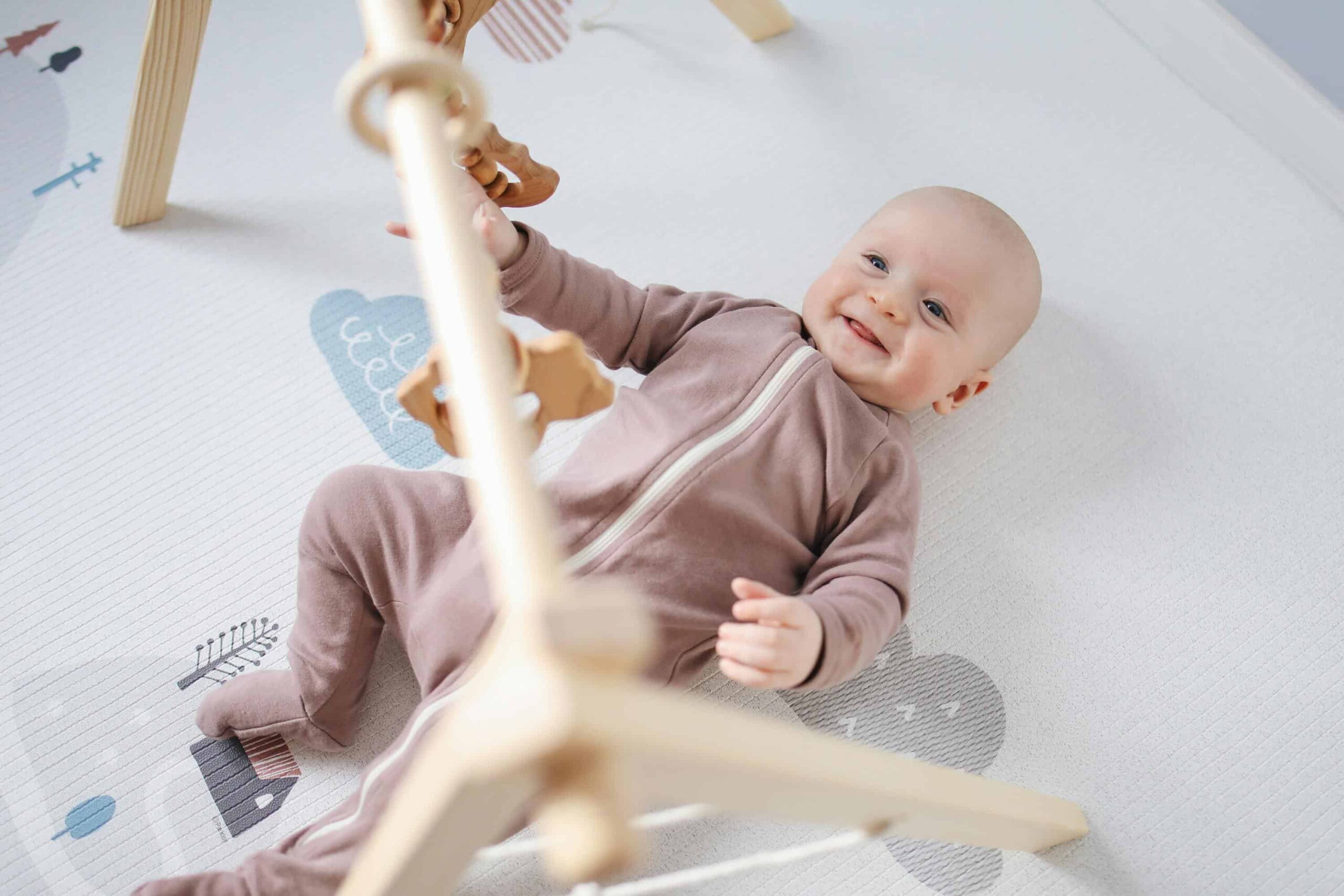Understanding TOG Rating

Introduction
Understanding TOG ratings is crucial for ensuring your baby stays comfortable and safe during sleep. In this blog, we’ll explore TOG ratings, including charts, temperature guides, and recommended products, to help you make informed choices for your baby’s sleepwear.
Become a Certified Pediatric Sleep Consultant:
ENROLL NOW
Overview:
Understanding TOG Rating Chart
TOG, which stands for Thermal Overall Grade, is a standard measurement used to assess the warmth of sleepwear and bedding. It helps determine how effectively a fabric can insulate and maintain warmth. For parents, understanding TOG ratings is essential to ensure your baby stays comfortable and safe while sleeping.
TOG ratings range from 0.2 TOG, which represents the lightest fabrics, to 3.5 TOG, indicating the heaviest and warmest materials. The lower the TOG rating, the lighter the fabric, making it suitable for warmer room temperatures. Conversely, a higher TOG rating means the fabric is thicker and better suited for cooler environments.
Here’s a brief overview of how TOG ratings work:
- 0.2 TOG: Ideal for room temperatures above 75°F (24°C). This rating is perfect for warm environments where minimal insulation is needed.
- 1.0 TOG: Suitable for room temperatures between 68°F to 75°F (20°C to 24°C). This rating offers moderate warmth, making it versatile for mild conditions.
- 2.5 TOG: Best for room temperatures between 61°F to 68°F (16°C to 20°C). This rating provides substantial insulation, keeping your baby warm in cooler rooms.
- 3.5 TOG: Designed for room temperatures below 61°F (16°C). This rating is ideal for very cold environments, offering maximum warmth.
Understanding the TOG rating chart helps guide you in selecting the appropriate sleepwear based on the temperature of your baby’s room. Properly matching the TOG rating with the room temperature helps prevent your baby from overheating or getting too cold, both of which can disrupt sleep and impact their overall health.
Here’s a simple TOG rating chart for quick reference:
| Room Temperature | Recommended TOG Rating |
| Above 75°F (24°C) | 0.2 TOG |
| 68°F to 75°F (20°C to 24°C) | 1.0 TOG |
| 61°F to 68°F (16°C to 20°C) | 2.5 TOG |
| Below 61°F (16°C) | 3.5 TOG |
Using this chart, you can confidently choose the right TOG-rated sleepwear for your baby, ensuring they remain comfortable and safe throughout the night.
TOG Temperature Guide
TOG ratings help ensure your baby is dressed appropriately for the room temperature, maintaining comfort and safety during sleep. Understanding TOG rating effectively prevents your baby from overheating or getting too cold.
Guidelines for Dressing Your Baby: When choosing sleepwear, consider the current room temperature and adjust your baby’s layers accordingly:
- For warm environments, keep layers light, using a 0.2 TOG sleep sack with minimal clothing, such as a short-sleeve bodysuit or just a diaper.
- In moderate conditions, balance warmth with a 1.0 TOG sleep sack and a single layer, like a long-sleeve bodysuit or pajamas.
- For cooler rooms, opt for a 2.5 TOG sleep sack, pairing it with additional layers such as a long-sleeve onesie and pants.
- In cold environments, ensure your baby is well-insulated with a 3.5 TOG sleep sack over multiple layers, such as a long-sleeve bodysuit and cozy pajamas.
Monitoring Room Temperature: To keep your baby comfortable, regularly check the room temperature using a reliable thermometer. If you notice temperature fluctuations, adjust your baby’s sleepwear promptly. This approach helps avoid overheating or underdressing, both of which can disturb sleep and affect your baby’s well-being.
Layering Tips for Optimal Comfort: Layering allows you to fine-tune your baby’s warmth based on the room’s conditions. Start with a breathable base layer, like a cotton bodysuit, and add layers as needed, depending on the TOG rating. Opt for materials that are soft and breathable, ensuring good air circulation and temperature regulation. Remember, it’s better to add or remove layers based on your baby’s needs than to rely solely on heavier sleepwear.
By thoughtfully applying TOG ratings and adjusting layers, you can create a sleep environment that ensures your baby stays cozy and comfortable throughout the night, regardless of the room temperature.
Advantages and Disadvantages
Advantages of Using TOG-Rated Sleep Sacks:
TOG-rated sleep sacks provide several significant benefits that contribute to a safer and more comfortable sleep environment for your baby. One of the primary advantages is the elimination of loose blankets, which can pose a risk of suffocation. By using a sleep sack, you ensure that your baby stays securely covered throughout the night, reducing the potential hazards associated with traditional blankets.
Another key benefit of better understanding TOG rating is the consistent warmth that TOG-rated sleep sacks offer. Unlike blankets that can be easily kicked off, sleep sacks remain in place, maintaining a steady temperature around your baby. This consistent warmth is crucial for promoting restful sleep, as it helps your baby stay at a comfortable temperature without frequent disruptions.
Additionally, TOG-rated sleep sacks come in various warmth levels, allowing you to choose the right TOG rating based on the specific room temperature. This customization ensures that your baby is neither too hot nor too cold, further enhancing their sleep quality.
Popular Sleep Sack Brands and TOG Options:
Several reputable brands offer high-quality TOG-rated sleep sacks, each with various options to meet different needs:
- HALO® SleepSack®: HALO® is well-known for its wide range of TOG-rated sleep sacks, offering options from 0.5 TOG for warmer climates to 3.0 TOG for colder conditions, providing flexibility for different environments.
- Love to Dream™: This brand specializes in sleep sacks with TOG ratings suitable for various room temperatures, including a 0.2 TOG option for hot weather and a 2.5 TOG choice for cooler conditions.
- ergoPouch: ErgoPouch offers organic cotton sleep sacks with TOG ratings ranging from 0.2 to 3.5, making them a versatile choice for all seasons and climates.
When selecting a sleep sack, consider your baby’s age, size, and typical room conditions. By choosing the appropriate TOG-rated sleep sack, you can create a safe, comfortable, and restful sleep environment for your baby every night.
Disadvantages of Using TOG-Rated Sleep Sacks:
While TOG-rated sleep sacks offer many advantages, there are a few potential drawbacks to be aware of:
- Limited Temperature Adjustment: Sleep sacks are designed for specific temperature ranges based on their TOG rating. If the room temperature fluctuates significantly, it can be challenging to adjust the warmth without changing the sleep sack entirely or adding/removing layers underneath.
- Cost: High-quality TOG-rated sleep sacks can be more expensive than traditional blankets or swaddles. As your baby grows, you may need to purchase multiple sleep sacks in different sizes and TOG ratings, which can increase the overall cost.
- Sizing and Fit: Finding the correct size for your baby can be tricky, especially if your baby is between sizes. A sleep sack that’s too large may pose a safety risk, while one that’s too small can be uncomfortable and restrictive.
- Layering Complexity: While sleep sacks reduce the need for blankets, you might still need to layer clothing underneath, particularly in colder temperatures. This can make dressing your baby for bed more complex, especially for parents new to using TOG-rated sleepwear.
- Limited Mobility: Some babies might find sleep sacks restrictive, particularly as they start rolling over or moving more in their sleep. This restriction can affect their comfort and ability to sleep soundly, especially if they’re used to more freedom of movement.
These potential disadvantages are relatively minor when weighed against the significant safety and comfort benefits that TOG-rated sleep sacks offer. However, they are essential considerations when choosing sleepwear for your baby.
Conclusion
Understanding TOG rating system is vital for ensuring your baby’s comfort and safety during sleep. Use TOG charts and temperature guides to make informed decisions when selecting sleepwear. With the right TOG rating, you can create a safe and cozy sleep environment for your baby. Start with a TOG-rated product that matches your baby’s typical sleep conditions, and proactively monitor and adjust their sleepwear as needed to maintain optimal comfort.
Learn about Becoming a Certified Pediatric Sleep Consultant:
ENROLL NOW
People Also Ask
Is a 0.5 TOG or 1.0 TOG better?
Answer: The choice between 0.5 TOG and 1.0 TOG depends on the room temperature. A 0.5 TOG is ideal for warm rooms above 75°F (24°C), while a 1.0 TOG is better for moderate temperatures between 68°F to 75°F (20°C to 24°C).
What TOG should a baby sleep in?
Answer: The ideal TOG rating for your baby depends on the room temperature. For warmer rooms (above 75°F/24°C), a 0.2 or 0.5 TOG is suitable. For moderate temperatures (68°F to 75°F/20°C to 24°C), choose a 1.0 TOG. Cooler rooms (61°F to 68°F/16°C to 20°C) require a 2.5 TOG, and for cold environments below 61°F (16°C), a 3.5 TOG is recommended.
How many blankets is a 0.5 TOG equivalent to?
Answer: A 0.5 TOG sleep sack is roughly equivalent to a single light blanket in terms of warmth. It’s designed to provide minimal insulation, suitable for warm weather or well-heated rooms.
What is the ideal TOG rating?
Answer: The ideal TOG rating depends on the room temperature where you sleep. A TOG rating of 1.0 is versatile for mild conditions, while a 2.5 TOG is better for cooler rooms. In very cold environments, a 3.5 TOG is ideal.
Do babies’ arms get cold in sleeping bags?
Answer: Babies’ arms can sometimes get cold in a sleeveless sleep sack, especially in cooler rooms. To prevent this, dress your baby in long-sleeve pajamas or use a sleep sack with sleeves for added warmth.
Can a baby overheat in a sleep sack?
Answer: Yes, a baby can overheat in a sleep sack if the TOG rating is too high for the room temperature or if they are overdressed underneath. Always choose a sleep sack with a TOG rating appropriate for the room temperature and monitor your baby for signs of overheating.
How do I know if my baby is too hot?
Answer: To check if your baby is too hot, feel their neck or back. If they are sweaty, flushed, or breathing rapidly, they may be overheated. Adjust their sleepwear and room temperature accordingly to keep them comfortable.

